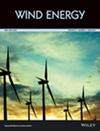间接驱动风力发电机传动系统瞬态转矩反转的缓解
IF 3.3
3区 工程技术
Q3 ENERGY & FUELS
引用次数: 0
摘要
风力发电机齿轮箱轴承失效是造成停机的重要原因之一。虽然众所周知,轴承故障导致最大的停机时间,但故障原因往往难以捉摸。轴承的设计满足其滚动接触疲劳(RCF)寿命。然而,它们经常在运行几年内突然和迅速失效。众所周知,这些过早失效是由于表面损伤,如白色表面剥落(WSF),白色蚀刻裂纹(WECs)和轴向裂纹。在这方面,动力传动系统中的瞬态扭矩反转(trs)已经成为表面损伤的主要诱因之一,正如本文所解释的那样。与TTRs相关的风险促使人们需要减少传动系统中由于各种瞬态事件而产生的TTRs。本文研究了三种缓解TTR的方法。首先,研究了两种现有装置,即扭转调谐质量阻尼器和非对称扭矩限制器,以证明它们的TTR缓解能力。在此基础上,提出了一种开环高速轴式机械制动控制的新思路。研究结果表明,虽然扭转调谐质量阻尼器和非对称扭矩限制器可以改善传动系统的扭转振动特性,但它们无法消除与扭转振动相关的轴承滑移风险。然而,本文提出的新方法可以通过在瞬态事件开始时启动高速轴制动器来改善高速轴的扭矩特性和降低轴承打滑的风险,从而减轻TTRs。此外,该控制方法能够减轻气动执行器在带宽和初始死区时间方面的机械限制。这种新颖的方法允许风力涡轮机使用涡轮机上现有的硬件来保护齿轮箱轴承免受trs的影响。本文章由计算机程序翻译,如有差异,请以英文原文为准。
Mitigation of transient torque reversals in indirect drive wind turbine drivetrains
Bearing failure in wind turbine gearboxes is one of the significant sources of down-time. While it is well-known that bearing failures cause the largest downtime, the failure cause(s) is often elusive. The bearings are designed to satisfy their rolling contact fatigue (RCF) life. However, they often undergo sudden and rapid failure within a few years of operation. It is well-known that these premature failures are attributed to surface damages such as white surface flaking (WSF), white etching cracks (WECs) and axial cracks. In that regard, transient torque reversals (TTRs) in the drivetrain have emerged as one of the primary triggers of surface damage, as explained in this paper. The risk associated with TTRs motivates the need to mitigate TTRs arising in the drive-train due to various transient events. This paper investigates three TTR mitigation methods. First, two existing devices, namely, the torsional tuned mass damper and the asymmetric torque limiter, are studied to demonstrate their TTR mitigation capabilities. Then, a novel idea of open-loop high-speed shaft mechanical brake control is proposed. The results presented here show that while the torsional tuned mass damper and the asymmetric torque limiter can improve the torsional vibration characteristics of the drivetrain, they cannot mitigate TTRs in terms of eliminating the bearing slip risk associated with TTRs. However, the novel approach proposed here can mitigate TTRs both in terms of improving the torque characteristic in the high-speed shaft and reducing the risk of bearing slip by actuating the high-speed shaft brake at the onset of the transient event. Furthermore, the control method is capable of mitigating TTRs with the mechanical limitations of a pneumatic actuator in terms of bandwidth and initial dead time applied to it. This novel approach allows the wind turbines to protect the gearbox bearings from TTRs using the existing hardware on the turbine.
求助全文
通过发布文献求助,成功后即可免费获取论文全文。
去求助
来源期刊

Wind Energy
工程技术-工程:机械
CiteScore
9.60
自引率
7.30%
发文量
0
审稿时长
6 months
期刊介绍:
Wind Energy offers a major forum for the reporting of advances in this rapidly developing technology with the goal of realising the world-wide potential to harness clean energy from land-based and offshore wind. The journal aims to reach all those with an interest in this field from academic research, industrial development through to applications, including individual wind turbines and components, wind farms and integration of wind power plants. Contributions across the spectrum of scientific and engineering disciplines concerned with the advancement of wind power capture, conversion, integration and utilisation technologies are essential features of the journal.
 求助内容:
求助内容: 应助结果提醒方式:
应助结果提醒方式:


